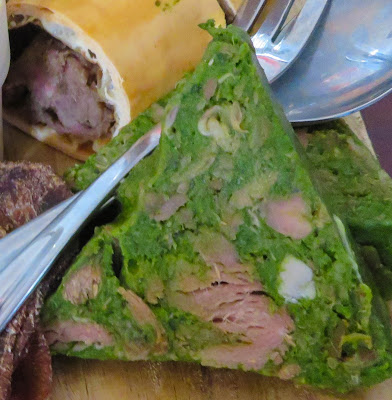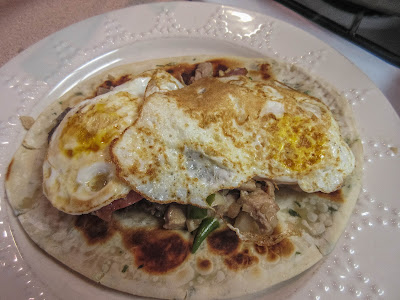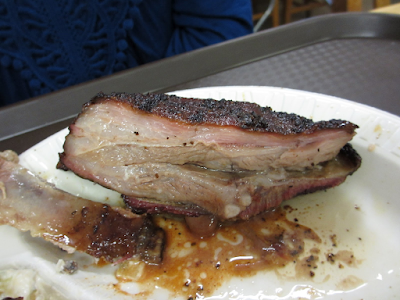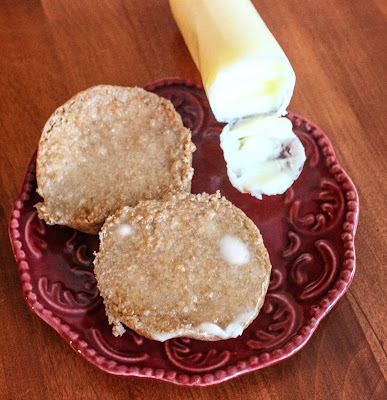IMPALA: Impala is an antelope in the south half of Africa. At Karibu, a restaurant in Cape Town, South Africa, we ordered the safari platter which included and impala steak, as well as kudu and springbok. Impala, which was cooked the most rare, was best.
 |
| The three steaks are to the upper left. |
 |
| Impala is in the middle. |
We ate impala at Carnivore restaurant in Johannesburg. My photo was very poor so I'm not using it. We also had impala at The Boma in Victoria Falls, Zimbabwe. The impala was very good.
 |
| Impala are the two red meats at the bottom. The white meat is crocodile. |
KANGAROO: I bought kangaroo medallions from Charlie Brown Farms in Littlerock, California. I wanted to get an authentic taste, so I cooked them without any additives, such as olive oil or salt. I cooked them rare. My son Andrew thought it tasted like liver. My daughter Rachael said it tasted sour. It was definitely gamy.
I also got a pound of ground kangaroo from Charlie Brown Farms. I added a goose liver and kidney to it, as I was cooking a goose at the same time, as well as red pepper, garlic, turnip and onions. It was pretty good.
Kangaroo salami from EMM is one of my favorite salamis they make. It tastes a lot like beef.
KUDU: Kudu is a beautiful antelope found in southern Africa. It was one of the most common wild meats we found there. The best kudu of the trip was at Arnold's in Cape Town. It came with a combination plate with multiple game meats. It was cooked rare and had a nice pepper gravy.
 |
| Kudu is on the left and ostrich on the right. |
At Karibu in Cape Town I had kudu steak as well as impala and springbok. The kudu was toughest, but if it had been more rare, I think I would like it more.
 |
| Kudu is left, impala middle and springbok right. |
We stayed at Halili Camp in Etosha National Park in Namibia. They served us kudu steak that night. It was rare and delicious.
Drywors or droewors (in Afrikaans, meaning dry sausage) is a sausage made with meat with no more than a 5% fat content. It is dried slowly in warm and dry conditions. We purchased kudu drywors in Cape Town and found it dry with very little moisture. It had a freeze-dried texture and I was not fond of it.
Pate is lean meat mixed with fat by grinding, sieving or pureeing it. I purchased kudu pate and found it very moist, with a slight liver taste and extremely good.
At The Boma Restaurant in Victoria Falls they had kudu stew with big chunks of moist kudu in gravy, as well as some Guines fowl.
 |
| Kudu is to the left. Guinea fowl is to the right. |
LAMB: Lamb is one of my favorite meats and I've had it many ways. One of the most memorable was lamb brain at Burj Al Hammam in the Intercontinental Amman in Amman, Jordan. This was quite a mental struggle as the brains looked just like what they are. They were cold and heavy with a texture like soft cheese. They were almost too lemony and salty.
We also got lamb sausages which were also too lemony.
Khash, or xas in Azeri, is a dish of boiled sheep feet (trotters). The hair is removed from the sheep feet, then they are cleaned and kept in cold water, then boiled all night long until the water is a thick broth and the meat has separated from the bones. The tendons melt into the soup and create a very thick broth and a silky taste. It was extremely thick from the collagen, marrow, gelatin, meat, fat and other ingredients and had absolutely no salt or other spices. It was so thick I wondered if a quarter dropped into it would be suspended. We had it at Anadolu Restaurant in Baku, Azerbaijan.
 |
| Sheep trotters from vidyascooking.blogspot.com. |
At Cafe Loki in Reykjavik, Iceland we head sheep had cheese (which they called jelly) which had large lamby bits and it was very good. We also got smoked lamb which kind of neutralized the lamb taste I loved the lamb meat soup.
At Cafe Mamartut in Ilulissat, Greenland we had smoked lamb with spinach. It was very moist and mild.
In Marrakech, Morocco, our guide took us into the souk behind the Jemaa el-Fna to Mechoui Alley which had a row of stalls that all sold sheep, across from olive vendors. We ordered a half sheep head without a brain, apparently the brains are sold separately at a different stall. When brought to our table it just looked like a pile of meat covered in a mixture of cumin and salt. We had the tongue, the cheek, and the eye and eventually the skull came into focus. It was fatty, flavorful and had great mouth-feel. One of my favorite meals ever.
 |
| Judy and our guide out front. The sheep head is cooked in the clay pots. |
 |
| It is hard to tell their is sheep head in this pile. |
 |
| Partially devoured. |
 |
| Almost completely devoured. |
 |
| The eye. |
At Incanto in San Francisco, Judy ordered roasted lamb neck with smashed roots, tatsoi rapini and gremolata. It was tender, melt-in-your mouth goodness. They cooked it for 15 hours at 200 degrees and it just fell off the bone. I got some tastes and regretted not ordering it myself.
At Tapas Barinn in Reykjavik, Iceland, we had raw lamb marinated in licorice sauce presented on a lava rock. Stunningly good, very tender, a clear licorice taste and a little sweet.
At Seki Restaurant in Baku, Azerbaijan we had piti, an Azeri soup, that includes the tail of a fat-tailed sheep. Most have fat-tails where the fat accumulates in baggy deposits in the rear end and on the first 3 to 5 vertebrae of the tail. First, Azeri flatbread is crumpled up, mixed with spices and added to a thick lamb broth. Second, a sheep tail, both fat and meat, is mixed with the lamb broth and vegetables (peas, chestnuts and saffron, in our case), mixed with more crumpled Azeri flatbread, then mixed with a pestle to break down the fat and meat. Either by design or ignorance, we first got lamb broth with sheep fat which we ate, then got a fairly dry concoction light light turkey stuffing, a mixture of lamb meat, fat, flat bread, vegetables and broth.
 |
| Fat-tailed sheep from Wikipedia. |
 |
| This is the piti combined, but we had both. |
At Cattleman's Steakhouse in Oklahoma City, Oklahoma, they have "lamb fries" which is a euphemism for lamb testicles.
The wife of one of my partners saw some lamb testicles in an oriental market and brought me a present of four of them. Having recently cooked bison testicles, I was surprised by how large they were. I parboiled them for five minutes and two imploded. The other two shrunk into water balloon like balls. The inside was white, unlike the bison testicles which were yellowish. The taste was mild, like knockwurst. I chopped them up and fried them with Thai chili, garlic, shallots, some elk and some sausage, then put them on a Chinese pancake with some over-easy eggs.
Lamb ribs at True in Montgomery, Alabama. They were grilled with pickled onions and yogurt sauce.
Mutton ribs from Southside Market and Barbecue in Elgin, Texas is some of the best barbecued meat I've ever eaten. I've even tried unsuccessfully to mail order them. In the U.S. "lamb" usually refers to a sheep of any age. In the U.K., New Zealand and Australia, lamb only refers to meat of a sheep under one-year old, the hogget is the next level, then mutton. In the U.S., if mutton is used, it refers to a sheep over two years old. I guess that is why these ribs were so large.
Lamb riblets from The Fort in Morrison, Colorado, tossed in a spicy citrus bbq sauce.
Lamb ribs from Y.O. Ranch Steakhouse in Dallas, Texas, dry rubbed and roasted, basted with a plum molasses wasabi glaze.
At Green Street Tavern in Pasadena, California I had Moroccan style lamb shank, deboned, in couscous, chickpeas and gravy.
At Mamounia Authentic Moroccan Cuisine in Anaheim, California, Judy got lamb shank with couscous and veggies. I got lamb shank cooked in a tagine (clay pot) with prunes, almonds, zucchini, yellow squash, carrots and apricots. Each of us thought we got the best dish.
At Meddlesome Moth in Dallas we had spiced lamb breast which was spread out and rolled into a roll and then cut into slices with an apparent spinach filling. The deep red color reminded me of corned beef. It was quite mild and white beans and a leek were decorative.
Judy got me sheep butter for Christmas. It was in a plastic package because when left out of a refrigerator it liquefied. It was only lightly salted and did not taste much different from cow butter.
At Red Medicine in Beverly Hills, California, we had a very beautifully and unusually presented lamb shoulder dish. The lamb was slow roasted with sequoia redwood shoots, ripe and unripe mango, yellow beets, preserved mustard seeds, puffed soymilk skin (on the yellow beets) and wild yarrow leaves. I believe the orange was tamarind.
 |
| The lamb. |
On a rural road on our way to Sarajevo, Bosnia & Herzegovina, I saw a spit-roasted lamb and chickens for sale. Judy was put-off by the long tail on the lamb. I requested a fairly large piece of the mid-section which we ate while we drove. It was incredible.
Our son Andrew, when he graduated from UCLA, wanted to slaughter and cook a lamb for his graduation party. This was inspired by reading Omnivore's Dilemma. Gregg Palmer, a good friend, donated a lamb. Andrew killed the lamb and dressed it with help and guidance from Gregg. I helped with the dressing. That evening, Andrew added rosemary, onions, garlic salt and olive oil to the liver and fried it and it was the best liver I've ever eaten. Judy, who doesn't particularly like liver, had seconds.
It was very difficult to get the skin off of the head. We cooked the head on the barbecue and ate the facial meat and part of the tongue. Andrew also stuffed the heart with garlic which we ate.
 |
| Tongue |
 |
| Heart |
In addition to the liver, we decided to barbecue a side of lamb ribs. We separated the rib cage with difficulty, put Corky's bbq seasoning rub on the ribs, garlic salt and rosemary, and grilled them. Lamb chops I've had before had the rib partially cut-off, because there is very little meat on them. Where the rib connects into the spinal column is where the wonderful chop or rack of lamb is. We didn't have the proper cutting tools, so had to dig into the backbone and cut away the meat, which was very good.
We had four legs to use for Andrew's graduation party in Santa Monica. We used one leg and cut the meat off into about three pounds of cubes which Judy used to make lamb stew. We barbecued the other three legs on our grill, turning off the two inside burners and using the two outside burners. They were wonderful, juicy legs of lamb.
LION: I got some lion stew meat and lion ribs from EMM. They were from a captive bred lion in the U.S. Anshu Pathak warned me that they would be lean and needed to be cooked sous vide. Unfortunately, our freezer was left ajar in a heat weave and we needed to cook it before we were ready and our sous vide was not available. I cooked them on indirect heat on the grill and it was tough, even though the ribs had quite a bit of fat on them. The lion was chewy, chewy, chewy.... The rib meat was the best: moist, fatty and a better flavor, but tough, tough, tough. The stew meat was not as good, and varied in toughness and taste from piece to piece.
 |
| Lion ribs (both sides - see next photo). |
 |
| Lion stew meat. |
I got a lion steak from EMM and was determined to do a better job on it. I brined it for nine hours which takes most of the blood out of it and turns it gray. I then put olive oil, salt, pepper and minced garlic in a sous vide bag and cooked it for 19 hours. The meat absorbed the garlic flavor, was moist, and pretty tender. We took it to a Thanksgiving dinner with another family and 12 people were served - each asked to take a taste without knowing what it was. All ate and enjoyed it.









































































Hey, what about my wonderful lamb stew? I thought it was one of your favorites. I guess it is too tame for this wild list of means. I agree that the roast lamb head in Morocco and the roadside barbecued lamb in Bosnia were some of the best and most memorable lamb experiences we've had.
ReplyDelete